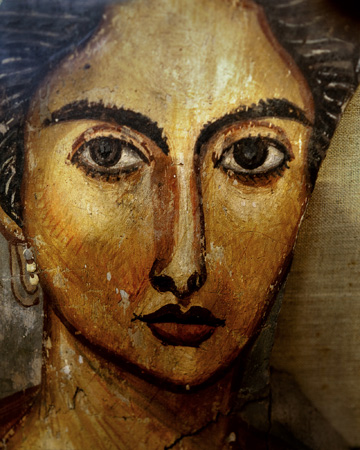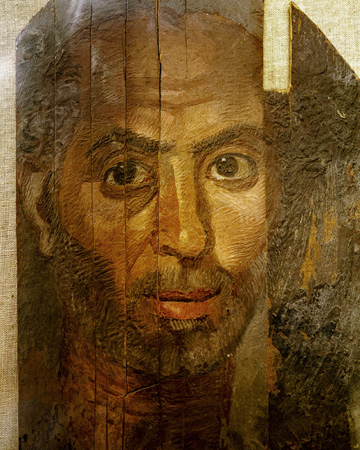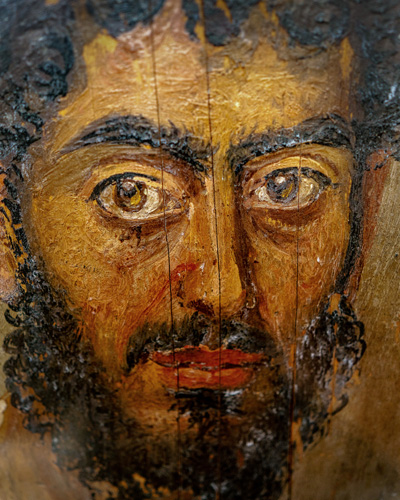s w i f t s & s l o w s: a quarterly of crisscrossings
Four Markers
Lyn Horton & Frank Ward
←back or next→
 Eyes, Frank Ward
Eyes, Frank Ward
As live people, as people who are alive, we face death in a time ahead of us, as if we are traveling in a desert of unknown circumstance and the death we may or may not fear is a mirage floating above the sand, glowing with light and the vibrations of heat waves, towards which we walk, but is seemingly out of our reach.
The processing of our lives has no form between now and the time we cross over from this second millennium world that is beset with horror that we were accustomed to imagining in movies, in books. Only a partial percentage of the collective we has done anything to act on eradicating the horror: the famine, the lack of water, the deforestation, the migrations.
But in our travels, both physical and emotional, we come upon amazing things that are replete with history. It is imperative to absorb and churn and turn around that history so we can move creatively, inspired and encouraged, questioning the present in the effort to present valid courses of action to take, to paint new pictures, to write new words, to exhale recycled fresh air and beliefs and maps that can only be the answers for the next set of questions to come.
These paintings were painted to cover Egyptian mummies, painted by Roman painters in the Fayum, an area of the past world, in an oasis near the Nile in Egypt in the onset of the first millennium. These paintings live in the Cairo Museum. A place where the past oozes from the walls, the encased objects, the ground it is built on.
These paintings signify media for transition. From the dead to the living.
How we see these paintings is to wonder about their nature.
The people whose faces are painted here show no fear.
They have done what they did. They have said what they have said.
We can impose our perspective on them without reading any labels.
 Geom, Frank Ward
Geom, Frank Ward
Tears, Frank Ward
We can ask:
How they move.
How they care.
How they know.
How they love.
How they dislike.
How they believe.
How they trade.
Where they live.
What their houses look like and if they are furnished and clean.How they speak.
How their voices sound.
How they smell.
How they eat.
How their bodies are well or sick.
Who cares for them.
Where their families are.
Where are their children.Who has children.
Who can do math.
Who can spell.
Who teaches.
Where are their schools.How do they travel.
Do they have pets.What are the differences between male and female perspectives.
What are their opinions and how are they expressed.Who is the carpenter.
Who is the slave.
Who is the aristocrat.
Who is poor.
Who is rich.
Who is gay.
Who is heterosexual.Who farms.
Where do the grass and flowers and trees surrounding them grow.
Where is the sun.
Where is the shade.
How does the day or the night alter what these people do.Who is an artist.
Who sews.
Who weaves.
Who makes pottery.
Who sweeps.
Who sings.
Who plays an instrument.
What instruments do they play.
What does the music sound like.Who philosophizes.
Who laughs.
Who cries.
Who questions.Who is wise.
Translating the message
The eyes on these painted faces
Send
Can radically
Affect
Who we feel we are.Theses eyes have seen you and me.
These faces have seen the global population, the earth, the moon, the stars.
The souls of whomever they represent have penetrated ours.
These eyes do not lie.These faces know the future.
Because they have lived it as much as we have
And survived.
 Curls, Frank Ward
Curls, Frank Ward
←back or next→
◊ ◊ ◊
Frank Ward is professor in the Holyoke Community College Visual Art Department, Holyoke, Massachusetts, USA. He has a Masters of Fine Arts degree from Bard College in New York. The National Endowment for the Arts/New England Foundation for the Arts awarded him a grant to work with the Puerto Rican community in Holyoke. The Polaroid Foundation and ViewCamera Magazine have awarded him grants to photograph in Tibet. The Rotary Foundation has funded his photography in India. He has made many trips to the former Yugoslavia with the Friends of Bosnia and the Center for Balkan Development. In 2011, he received a Massachusetts Cultural Council Award for his photography in the former Soviet Union. In 2012, he was given the position of Cultural Envoy in Uzbekistan and Tajikistan for the US Department of State. His work has been exhibited throughout the United States and Europe. In 2006, Amherst College Press published “Curious Footprints,” a book of natural history photographs with an essay by Nancy Pick and an afterword by Ben Lifson.
Lyn Horton has been an artist for over forty years dedicated to maintaining a whole life experience now more than ever. She has a long history writing about creative improvised music for well-known publications, reviewing recordings, interviewing musicians and composing editorials. She has exhibited her art work extensively and is represented by the Cross MacKenzie Gallery in Washington, D.C. Horton was commissioned in 2012 to do a piece for the US Embassy in Vientiane, Laos. Her photography can be seen on Instagram.
